Pathfinder 1: The airship that could usher in a new age
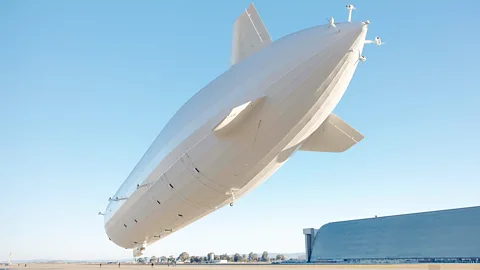 LTA Research
LTA ResearchPathfinder 1, bankrolled by a Google billionaire, is an attempt to revive the airship. A century after terrifying disasters, is it a safe-enough bet?
On 24 October 2024, a brief post was shared on the social media network LinkedIn. In it Google co-founder Sergey Brin's airship company LTA Research finally announced Pathfinder 1's first if brief untethered flight at Nasa's Moffett Field in California, part of the space agency's Ames Research Center. "This morning, Pathfinder 1 reached another milestone: untethered outdoor flight. This successful test marks another important step in our journey, and we are excited to build on this achievement through our rigorous testing program."
Airships are hard to hide. Despite the secrecy, one YouTuber filmed it from the road and uploaded it to the video-sharing site.
"Pathfinder 1 is a pretty amazing vehicle," says Alan Shrimpton, editor of the Airship Journal. "It is the first fully rigid airship, certainly of that size, for a very long time, and there was a great expectation that it would fly shortly after it began its outdoor testing programme.
"But Alan Weston [founder and former CEO of LTA Research] always said the biggest fault with rigid airships was that people in the past rushed their development and they were not going to make that same mistake. They were going to check it and check it again – and they did."
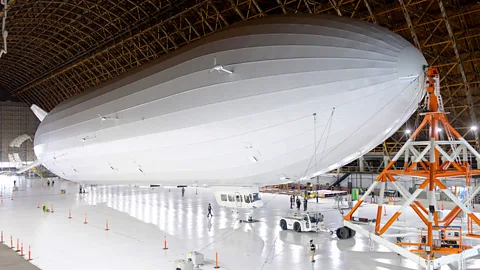 LTA Research
LTA ResearchThe understated tone in LTA's post belies the historic achievements of Brin's company so far. This was the first flight of the first airship built by the Google cofounder's company, the first time a classic rigid airship of this size had flown since the 1930s, and the first of a new generation of airships. The last giant rigid airship Graf Zeppelin II flew for the final time on 20 August 1939, 12 days before World War Two started, and was scrapped the following year. Rigid airships have a complex metal framework that supports a huge envelope filled with enough hydrogen or helium to lift a sizeable number of passengers, or cargo such as disaster relief, for days at a time.
Hydrogen-filled airships are also symbols of the Golden Age of the airship. The era between the world wars when the promoters of the technology beguiled the public with promises of scheduled commercial passenger services between destinations like Europe and North America, and North America and the Pacific, and in some cases delivered on these promises. The Graf Zeppelin flew "the first regularly scheduled, nonstop, intercontinental airline service in the history of the world" between Germany and South America, and was far faster than ocean liners that plied the route.
But the crash of the airship Hindenburg in 1937 – which killed 36 people including one person on the ground – showed the drawbacks of the flammable gas used as buoyancy. The airship faded into obscurity; just as conventional aircraft design surged ahead.
Eighty-six years later in November 2023, Pathfinder 1 emerged for the first time from the historic Hangar Two at Moffett Field to begin its outdoor flight-testing programme. But the largest aircraft in the world stayed stubbornly tethered to the ground to the frustration of many aviation enthusiasts. Its expected first flight just didn't happen.
But thanks to the Google co-founder's deep pockets, LTA Research appears to have the freedom to wait-to-get-it-right that others have not always had.
They have used this freedom to, for example, find better materials than lightweight aluminum alloys like duralumin to construct the giant frame of a rigid airship from, and cotton-composite materials and even cow guts to make the envelope out of, and gain a much better understanding of aerodynamics involved in flying very large airships. And it seems like they have been able to cautiously flight test their creation, without the over confidence and pressure from investors that have been a problem in the past.
"People said that they could not do it and that it was impossible," says Janne Hietala, CEO of Kelluu Airships, whose 10 autonomous drones, each of which can be transported in a 12m (40ft) sea container, are currently "the world's largest" fleet of airships. "This is a brilliant, very bold attempt to do the hard work, the engineering that is required, to mass-manufacture big airships. I don't think they will build hundreds of those because of the difficulties in mass-manufacturing airships of that size, but it's still possible."
Pathfinder 1 is not a historical replica. It is a proof-of-concept airship designed to see if a rigid design can be updated with new materials.
In particular, LTA Research wants to solve the thorny problem of how to mass produce aircraft of this size. It wants to build production models in Goodyear Airdock in Akron, Ohio, where the great US rigid airships of the 1930s were built.
"I've been down to Moffett Field to see Pathfinder 1 twice, and it is really an amazing thing to see in person," says John Geoghegan, author of When Giants Ruled the Sky. "It's very impressive to be able to see the learning they have made from the past even from the outside."
The fact that the giant rigid airship does not have tail fins in the traditional cross shape, but at an angle, is an example of such learning, because airships float up and down on a mooring mast and the bottom tail fin used to get damaged. Likewise, the airship's engines are no longer inline but staggered along its length to reduce the wind, drag and vibration that they used to cause. Like many other new designs, it uses helium as a lifting gas to prevent the infernos that doomed the Golden Age of the airship.
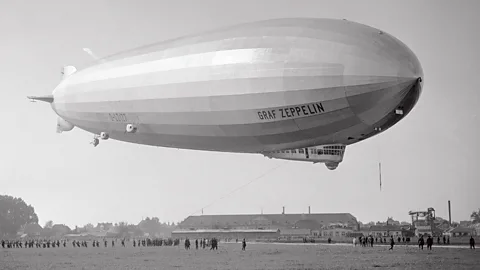 Getty Images
Getty ImagesHelium is less flammable than hydrogen, but there is a trade-off for this increased safety. It generates less lift than hydrogen, and it is in short supply. This makes it very expensive to fill the envelope of an airship with.
"There's a lot of baggage around airships, and a lot of people who have pre-set ideas about them, and so these guys are being incredibly careful and extremely cautious about the information they release," Geoghegan adds. "They do not want to do anything to contribute any more negative publicity. For the public always remember the airship disasters and not the successful flights."
Pathfinder 1's first untethered flight also has significance for the wider lighter-than-air community, which has for a long time had little more than glossy CGI graphics of large airships to show investors. That it has occurred at a time when high-profile airship companies such as Flying Whales "appear to be struggling to… build a flagship production facility" is a good morale boost for the sector, says Shrimpton.
"Investors tell so many people going out to try to get funding for their lighter-than-air projects that yes, it's interesting, I can see the benefits of it, but show me one that is flying today… now they can."
"It is fantastic that LTA Research is making so much progress using modern technology to solve these problems," says Diana Little, co-founder of airship startup Anumá Aerospace. "It reminds people about the capabilities of lighter-than-air flight.
"Aviation is an industry desperately looking for a decarbonisation solution and airships are part of that solution," Little adds.
The first flight of Pathfinder 1 has been at least 12 years in the making. Brin's interest in airships seems to have begun in 2012 around the same time as a modern semi-rigid Zeppelin NT (New Technology) airship began tourist flights from Moffett Field.
The following year he founded LTA Research Ltd and in 2017 his airship company began to lease space at Moffett Field and research began at the Akron Airdock. There they built a 12-engine, 50ft-long (15m) electric "baby airship" to test their technology.
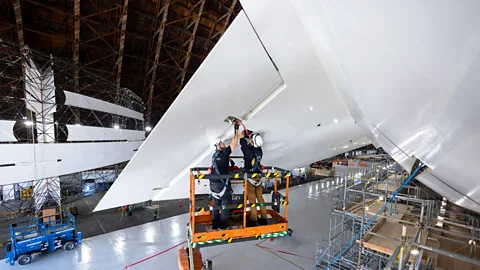 LTA Research
LTA ResearchNo one had built aircraft like these giant rigid airships for decades. So, it took time for the engineers to learn how to do this, particularly with a focus on safety and not repeating the mistakes of the past. In the 1930s, the materials used to create the such rigid airship's framework and envelope which were simply not strong enough to deal with the stresses of flight.
The use of computerised controls, new and much stronger lightweight materials like carbon fibre and titanium to construct the complex skeleton of the rigid airship are just some of the ways the giant rigid airship has been brought into the 21st Century. So too are the use of flame-retardant synthetic materials for the envelope of the airship, sensors to monitor the helium and engines that can be rotated to provide vectored thrust.
The knowledge and skills of the great engineers of the past had to be relearned by LTA – together with the latest research and technology – in order to design the airship and work out how to mass produce even larger craft in the future. Rather than expect their engineers to work at the top of unsteady 85ft-high (26m) ladders to build these ships like they did in the 1930s, LTA have designed a massive cradle-like structure that allows the workers to stay on the ground while the giant ships are slowly rotated in front of them. To do this they needed to find the skilled workers who were willing to join a risky project that may one day make aviation history, and are continuing to seek them today.
In 2017 work started at Moffett Field on LTA's smallest airship Pathfinder 1, and planning began in Akron on the Pathfinder 3, its successor which is planned to be one-third-larger. (There is no Pathfinder 2.)
But a fully-fledged return of large airships is not yet a given. "I am crossing my fingers," says Shrimpton, "but if Pathfinder 1 suffered a failure in flight everybody would point to it and say, 'See once again, a large airship crashes – it is not safe,' which would provide an almost insurmountable hurdle for the whole passenger/cargo-carrying airship industry."
The same applies to other airship companies, such as Flying Whales, whose airship has not even been built yet. "They need to get over that same hurdle and prove to the public that they have a vehicle that is safe, like LTA Research is doing."
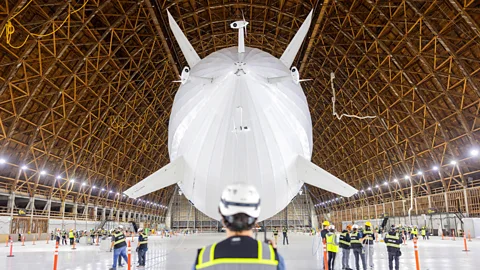 LTA Research
LTA ResearchGeoghegan is more sanguine about it. "Interest in airships is cyclical," he says. "Every 10 or 15 years a company comes along that is working in the airship category and a couple more sprout up. Some get prototypes flying. But none of them ever pan out.
"So, there is a lot of skittishness among the investor community about building these things. It is in part about the technology, is it robust enough to work. Then, second, what is the business application? Is there a market that exists that would financially support airships on this scale?
More like this:
• The giant hangar poised for an aviation revolution
"We keep hearing the same things trotted out. One is for tourism. One is for disaster relief. One is that it will be a green, non-polluting alternative to conventional aircraft, and the fourth one is specialised cargo.
"But I remain to be convinced that there's an economic case for these things."
The engineering challenges that LTA faces certainly remain significant.
"In the end, for LTA Research it is proof that their design worked, and a milestone for their staff, who worked tirelessly for three or four years to bring the design to fruition," says Shrimpton. But Pathfinder could have much wider implications if it successfully takes to the skies. "It is really important. It is something the whole airship industry needs – to be seen in the sky."
--
If you liked this story, sign up for The Essential List newsletter – a handpicked selection of features, videos and can't-miss news, delivered to your inbox twice a week.
For more science, technology, environment and health stories from the BBC, follow us on Facebook, X and Instagram.
